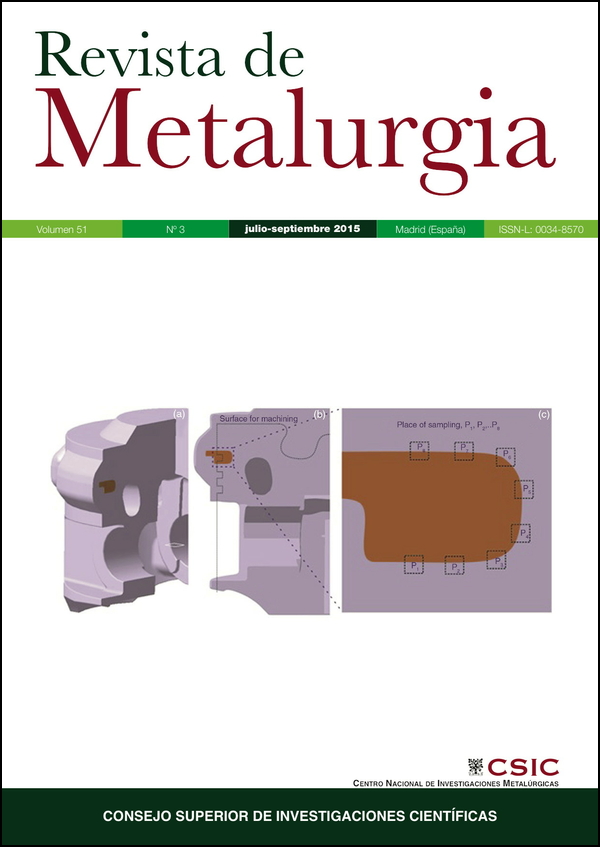Low friction coefficient coatings Ni-Cr by magnetron sputtering, DC
DOI:
https://doi.org/10.3989/revmetalm.047Keywords:
Mechanical alloying (MA), Magnetron sputtering, Ni-Cr coatingsAbstract
Magnetron Sputter Deposition technique with DC was used for the deposition of Ni-Cr coatings on AISI 316 SS like substrate. The cathode with a nominal composition Ni-22 at% Cr was prepared by Mechanical Alloying (MA) technique, with a maximum milling time of 16 hours and, with a high energy SPEX 8000 mill. The coatings were made under Argon atmosphere at room temperature with a power of 100 W at different times of growth. Chemical composition, microstructure, topography, nanohardness and wear of the coatings were evaluated using the techniques of microanalysis by energy dispersive X-ray analyzer (EDAX), X-Ray Diffraction (XRD), Atomic Force Microscopy (AFM), Nano-indentation and pin-on-Disk, respectively. After milling, was not detected contamination in the mixtures. XRD analysis revealed that the microstructure of the Ni-Cr alloy was maintained in the coatings with respect to MA powders, with some degree of recrystallization. Nanohardness values were in the order of 8.8 GPa with a Young’s modulus of 195 GPa. The adhesion of the films was evaluated according to their resistance to fracture when these were indented at different loads using Vickers microhardness. The wear test results showed a decrease in the friction coefficient with respect to the increase of thickness’ films, getting a minimum value of 0.08 with a thickness of 1 μm and which correspond with the maximum growing time.
Downloads
References
Agüero, A. (2007). Recubrimientos contra la corrosión a alta temperatura para componentes de turbinas de gas. Rev. Metal. 43 (5), 384–398.
ASTM G99-05 (2010). Standard Test Method for Wear Testing with a Pin-on-Disc Apparatus, ASTM International.
ASM Handbook (2002). Alloy Phase Diagrams, Vol. 3, ASM International, Materials Park, OH, p. 155.
Bermúdez, M.D., Carrión, F.J., Ginés Martínez, N. (2003). Erosión-corrosión de tantalio, titanio y aceros inoxidables, IX Congreso de Ciencia y Tecnología de Materiales, Madrid, Espa-a.
Bunshah, R.F. (2001). Handbook of Hard Coatings, Chapters 2 and 3, Published William Andrew.
Mattox, D.M. (2010). Handbook of Physical Vapor Deposition (PVD) Processing, Chapter 1, Second Edition, Elsevier.
Mischler, S., Spiegel, A., Landolt, D. (1999). The role of passive oxide films on the degradation of steel in tribocorrosion systems. Wear 225–229, 1078–1087. http://dx.doi.org/10.1016/S0043-1648(99)00056-3
Oliver, W.C., Pharr, G.M. (1992). An improved technique for determining hardness and elastic modulus using load and displacement sensing indentation experiments. J. Mater. Res. 7 (6), 1564–1583. http://dx.doi.org/10.1557/JMR.1992.1564
Ou, X.-M., Sun, Z., Sun, M., Zou, D.-L. (2008). Hot-corrosion mechanism of Ni-Cr coatings at 650 °C under different simulated corrosion conditions. J. China Univ. Mining & Technol. 18 (3), 444–448. http://dx.doi.org/10.1016/S1006-1266(08)60092-9
Zhao, G.-G., Zhou, Y.-B., Zhang, H.-J. (2009). Sliding wear behaviors of electrodeposited Ni composites coatings containing micrometer and nanometer Cr particles. T. Nonferr. Metal. Soc. China 19 (2), 319–323. http://dx.doi.org/10.1016/S1003-6326(08)60271-X
Zhou, Y.-B., Zhao, G.-G., Zhang, H.-J. (2010). Fabrication and wear properties of co-deposited Ni-Cr nanocomposite coatings. T. Nonferr. Metal. Soc. China 20 (1), 104–109. http://dx.doi.org/10.1016/S1003-6326(09)60104-7
Published
How to Cite
Issue
Section
License
Copyright (c) 2015 Consejo Superior de Investigaciones Científicas (CSIC)

This work is licensed under a Creative Commons Attribution 4.0 International License.
© CSIC. Manuscripts published in both the printed and online versions of this Journal are the property of Consejo Superior de Investigaciones Científicas, and quoting this source is a requirement for any partial or full reproduction.
All contents of this electronic edition, except where otherwise noted, are distributed under a “Creative Commons Attribution 4.0 International” (CC BY 4.0) License. You may read the basic information and the legal text of the license. The indication of the CC BY 4.0 License must be expressly stated in this way when necessary.
Self-archiving in repositories, personal webpages or similar, of any version other than the published by the Editor, is not allowed.
















